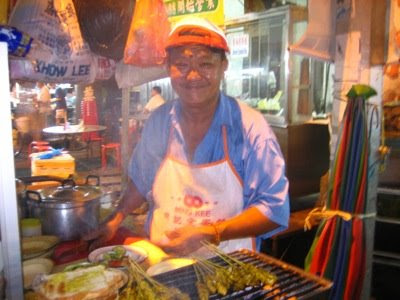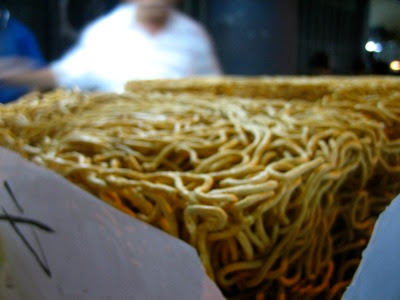As mentioned in my previous entry, the island of Penang has three prominent cultural groups; Indian, Chinese and Malay. It’s time to explore some of the foods whipped up by the latter two ethnic communities.
I was told that Pulau (island) Penang is 65% Chinese and it’s evident in the almost overwhelming amount of noodles stands, chicken-rice restaurants and steamed bun shops. Some foods are traditional Chinese (Chicken Rice), while others such as Char Kway Teow would be probably considered Chinese influenced as I’m not sure how regularly you’d find this exact dish outside of Malaysia.
As for Malay foods, Satay is said to have originated in Indonesia, but has become popular in other countries such as Thailand and Malaysia. On the other hand Cendol is a local specialty. I don’t think any other place makes it exactly like Penang does but I did spot a variation of this dessert in Kota Bharu (Eastern Malaysia).
Anyways, on with the show. Here’s a sampling of what I managed to gnaw on in my 48 hour Penang rendezvous.
I was told that Pulau (island) Penang is 65% Chinese and it’s evident in the almost overwhelming amount of noodles stands, chicken-rice restaurants and steamed bun shops. Some foods are traditional Chinese (Chicken Rice), while others such as Char Kway Teow would be probably considered Chinese influenced as I’m not sure how regularly you’d find this exact dish outside of Malaysia.
As for Malay foods, Satay is said to have originated in Indonesia, but has become popular in other countries such as Thailand and Malaysia. On the other hand Cendol is a local specialty. I don’t think any other place makes it exactly like Penang does but I did spot a variation of this dessert in Kota Bharu (Eastern Malaysia).
Anyways, on with the show. Here’s a sampling of what I managed to gnaw on in my 48 hour Penang rendezvous.
 Laksa! The unofficial official dish of Malayia. It’s essentially a rice noodle soup although in penang you will only find the regional variation: Asam Laksa.
Laksa! The unofficial official dish of Malayia. It’s essentially a rice noodle soup although in penang you will only find the regional variation: Asam Laksa.Asam Laksa differs from the standard coconut milk-curry Laksa in that the soup base consists of shredded mackerel and tamarind. The tamarind provides a mouth puckering sour element while the shredded fish add a savory yet not overpoweringly fishy addition to the soup. Chinese greens, hot peppers and red onion are also added. The soup actually got tastier and tastier the more I ate, all the way until the final slurp.
In the video you can see how Jimmy fans the coals to get them red hot. This gives the satay sticks a nice char, which of course makes them tastier than a char-free satay stick.
 Served with red onion, cucumber and a coconut milk peanut sauce. Mmm. You can get 10 for about US $1.60.
Served with red onion, cucumber and a coconut milk peanut sauce. Mmm. You can get 10 for about US $1.60. Cendol. Shaved ice, black sugar syrup, Indonesian sweetened red beans, sweetened pea flour noodles and coconut milk.
Cendol. Shaved ice, black sugar syrup, Indonesian sweetened red beans, sweetened pea flour noodles and coconut milk.I’m not even going to begin to attempt to legitimize this dish, but I figure the ice cools off the locals.
Just too sweet for my teeth, though. Still, respect for creativity.
 Chicken rice, a haianese import.
Chicken rice, a haianese import.This dish comes from the Chinese island of Hainan but can now be found anywhere from Singapore to Shanghai.
It’s basically chicken atop of rice. You can get you chicken boiled or broiled (the waiter suggested broiled). For being breasts, the chicken I ate wasn’t the least bit dry- I was impressed. The stock made from the boiled chickens is also used to cook the rice, imparting chicken goodness deep into those puffy kernels. I also ordered one Loh Bak, which is a Chinese style deep fried sausage, which I might have even enjoyed even more than the chicken.
 Che Cheong Fun.
Che Cheong Fun.This is a simple, satisfying dim-sum dish. You have rolled-up sheets of rice noodles which are cut like you would cut steaks from a beef filet. Top it off with some peanut-sesame-shrimp sauce and have fun picking them up with your chopsticks.
 Wan tan Mee: Fresh shrimp wan tan wrappers, bbq pork, greens and egg noodles in a pork broth. It was definitely a GOOD noodle soup, but in comparison with the other foods it didn’t impress me all too much.
Wan tan Mee: Fresh shrimp wan tan wrappers, bbq pork, greens and egg noodles in a pork broth. It was definitely a GOOD noodle soup, but in comparison with the other foods it didn’t impress me all too much. This dish was awesome. Curry Mee. In Malay, mee means ‘noodle’ just so we’re clear. Anyhoo, egg noodles, cockles, mint and tofu (took a break from meat) take a coconut curry bath inside this bowl of heaven. This was a tongue scorcher, but I couldn’t stop sucking it down. One of my favorites for only US $0.80
This dish was awesome. Curry Mee. In Malay, mee means ‘noodle’ just so we’re clear. Anyhoo, egg noodles, cockles, mint and tofu (took a break from meat) take a coconut curry bath inside this bowl of heaven. This was a tongue scorcher, but I couldn’t stop sucking it down. One of my favorites for only US $0.80 Char Kway Teow.
Char Kway Teow.Char = Fried
Kway Teow = Rice Noodles
Another dandy from the streets of Georgetown. I compare this somewhat to Phat Siew in Thailand. Both contain flat rice noodles cooked with soy sauce and egg. Char Kway Teow also has shrimp, cockles and Chinese chives.
Penang=Tasty.






1 comment:
Jimmy's just trying to get a nice char on them.
Post a Comment